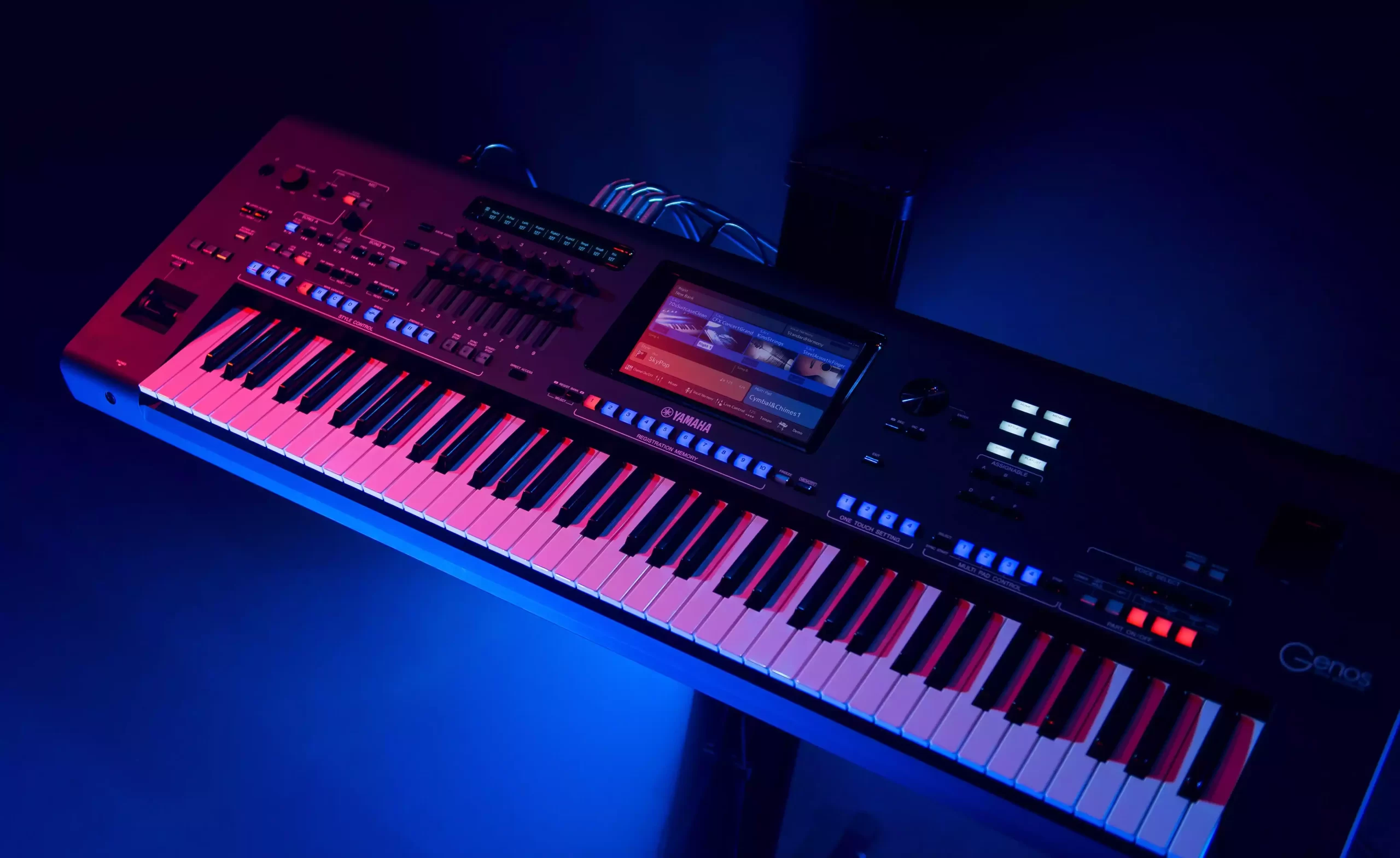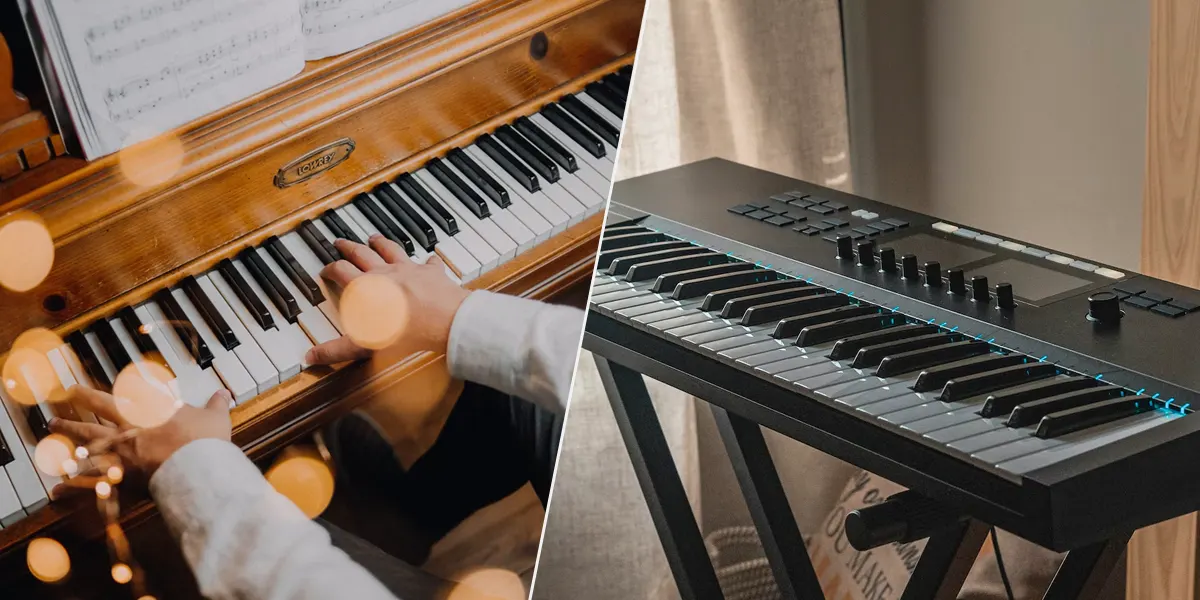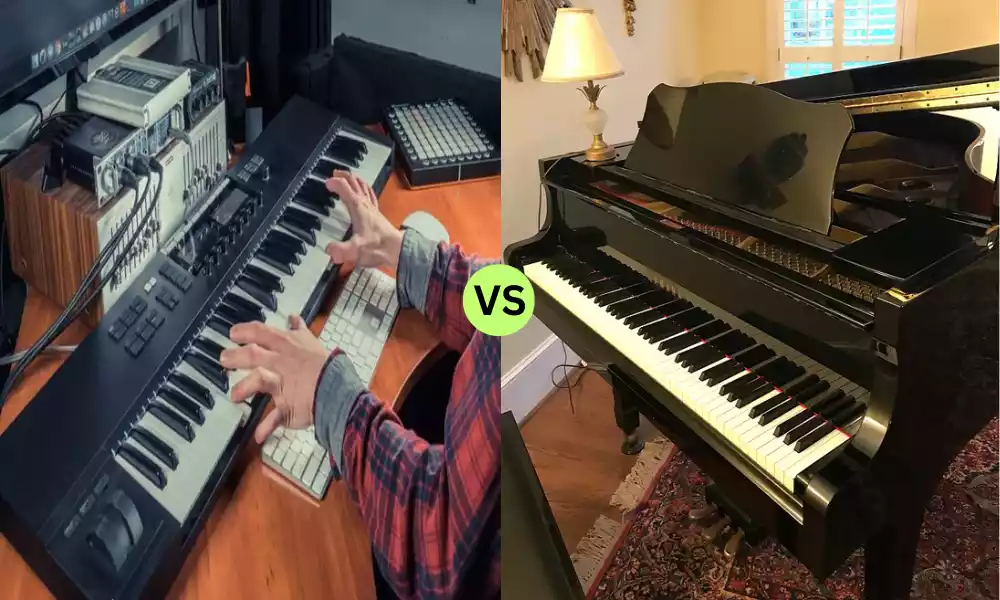Keyboard and Piano: The piano, an iconic and classical instrument, has been at the heart of musical composition and performance for centuries. Characterized by its large frame and acoustic sound generated by hammers striking strings, it has been the centerpiece in concert halls and homes alike. On the other hand, the keyboard, a more modern and versatile instrument, offers a compact and portable design, often enhanced with digital functionalities that allow for a variety of sounds and effects.
While both share a common layout of keys and are used to produce melodious tunes, they differ in various aspects such as construction, sound production, and playability, each holding its unique charm and significance in the world of music.
Historical Background
Historical Background of the Piano and Keyboard
Historical background of Piano:
- Origins:
- The piano’s predecessor, the harpsichord, was popular during the Renaissance and Baroque periods. Unlike the piano, the harpsichord plucked its strings.
- The fortepiano, the early version of the modern piano, was invented around the year 1700 by Bartolomeo Cristofori in Italy.
- Evolution:
- During the 18th century, the fortepiano underwent several modifications, transitioning from a simple instrument with limited dynamic range to a more robust one with richer sounds.
- By the 19th century, advancements in metallurgy allowed for the creation of stronger iron frames, leading to the modern grand piano structure. This enabled pianos to produce louder sounds and sustain notes longer.
- Cultural Impact:
- In the Classical and Romantic eras, renowned composers like Mozart, Beethoven, and Chopin expanded the piano’s repertoire, making it a central instrument in Western music.
- Pianos became household staples among the upper and middle classes, symbolizing cultural refinement.
Historical background of Keyboard:
- Origins:
- The electronic keyboard has its roots in the early 20th century with the invention of the electric organ, notably the Hammond organ in the 1930s.
- The Mellotron, developed in the 1960s, was among the first keyboards to use tape loops to generate sounds, paving the way for future electronic keyboards.
- Evolution:
- The 1970s and 80s saw the rise of synthesizers from brands like Moog, Roland, and Yamaha, revolutionizing music with electronic sounds.
- With the advancement of digital technology in the 1980s, digital pianos emerged, mimicking the acoustic piano sound and feel but in a more compact form.
- Cultural Impact:
- Keyboards and synthesizers became central to pop, rock, and electronic music from the 1980s onwards. Bands like The Beatles, Pink Floyd, and Kraftwerk extensively used these instruments.
- With portability and diverse sound capabilities, keyboards expanded musical possibilities, allowing artists to experiment and produce various genres and sounds.
Both the piano and the keyboard have significantly impacted music throughout history, each with its unique contribution and evolution, shaping the sounds and styles we recognize and love today.
What is a Keyboard?
A keyboard, in the context of musical instruments, refers to an electronic or digital instrument that mimics the design of a piano with its series of black and white keys. Unlike traditional pianos, keyboards generate sound electronically and often offer a broader range of sounds, features, and functionalities.

Here are some key attributes of a keyboard:
-
- Sound Generation: Keyboards produce sound through electronic or digital means. They use synthesized or sampled tones, which can replicate various instruments such as pianos, organs, strings, brass, and more.
- Portability: Keyboards are generally lightweight and compact compared to traditional pianos, making them more portable and suitable for various settings, from stage performances to small living spaces.
- Variability: Many keyboards come with a variety of built-in rhythms, accompaniments, and sound effects, allowing for a wide range of musical expressions.
- MIDI and Connectivity: Modern keyboards often have MIDI (Musical Instrument Digital Interface) capabilities, allowing them to connect to computers and other devices for music production, recording, or learning.
- Amplification: While some keyboards come with built-in speakers, others require external amplification. The volume is electronically controlled, and headphones can often be connected for private practice.
- Maintenance: Keyboards generally require less maintenance than acoustic pianos, as they don’t need tuning and are less affected by environmental factors like humidity and temperature.
- Price Range: Keyboards typically come in a wide price range, from inexpensive models suitable for beginners to professional-grade instruments with advanced features and sound quality.
While “keyboard” can also refer to the array of keys on devices such as computers, typewriters, or smartphones, in the musical context, it denotes an instrument that provides a modern, versatile approach to piano-like sound creation and musical expression.
What is a Piano?
A piano is a large acoustic musical instrument, part of the keyboard family, that produces sound by striking strings with hammers. The resulting vibration of the strings creates sound, which is then amplified by the wooden body and soundboard of the instrument.

Here are some key attributes and characteristics of the piano:
- Sound Generation: The piano produces sound acoustically. When a key is pressed, a hammer inside the piano strikes one or more strings (depending on the note). The vibration of the string is transferred to the soundboard, which amplifies and resonates the sound.
- Types of Pianos:
- Grand Pianos: These have a horizontal design with the strings extending away from the keyboard. They are known for their superior sound quality and are often found in concert halls.
- Upright Pianos: These have a vertical design, making them more compact. The strings and soundboard are vertical, making them suitable for homes and smaller spaces.
- Pedals: Pianos typically have two to three foot-operated pedals that affect the sound in various ways:
- Soft Pedal (or Una Corda): Reduces volume and slightly changes the tone by shifting the hammers so they hit fewer strings.
- Sostenuto Pedal: Sustains only the notes that are being held down when the pedal is pressed.
- Damper Pedal (or Sustain Pedal): Lets the strings vibrate freely, sustaining the sound even after the key is released.
- Tuning: Pianos require regular tuning to keep them sounding their best. Over time, the tension of the strings can change due to environmental factors like humidity and temperature, causing the piano to go out of tune.
- Size and Weight: Pianos are heavy and large, especially when compared to keyboards. Even the smallest upright pianos weigh several hundred pounds.
- Historical Significance: Invented in the early 18th century by Bartolomeo Cristofori, the piano has become a central instrument in Western music, cherished for its expressive range and dynamic capabilities.
- Learning and Playability: The piano’s weighted keys and dynamic range make it an excellent instrument for learning music theory and developing finger strength and dexterity.
- Cultural Impact: The piano has been pivotal in various music genres, from classical and jazz to rock and pop. It has been celebrated by composers, performers, and audiences alike for its versatility and emotive capabilities.
In essence, the piano is a cherished musical instrument with a rich history, known for its depth of sound and ability to convey a wide range of musical emotions.
Comparison Table of Keyboard and Piano
Below the comparison table of keyboard and piano:
| Feature/Aspect | Piano | Keyboard |
|---|---|---|
| Sound Generation | Acoustic (hammers striking strings) | Electronic or digital (synthesized or sampled tones) |
| Size & Weight | Large and heavy (especially grand pianos) | Compact and lightweight |
| Portability | Not portable (fixed position) | Highly portable |
| Sound Variety | Primarily piano sound | Multiple instrument sounds, effects, and rhythms |
| Maintenance | Requires regular tuning and care | Minimal maintenance |
| Volume Control | Natural dynamics (soft to loud based on key pressure) | Electronically controlled; adjustable volume levels |
| Pedals | Typically 2-3 (soft, sostenuto, sustain) | Often 1 (sustain), though some advanced models may have more |
| Learning Curve | Steeper due to weighted keys | Generally easier for beginners |
| Cost | Generally more expensive | Range from inexpensive to high-end |
| Connectivity | None (unless it’s a player piano or has added tech) | Often has MIDI, USB, and other connection options |
| Amplification | Natural acoustics or external microphones | Built-in speakers or external amplification |
| Key Weight | Weighted keys for dynamic play | Varies: non-weighted, semi-weighted, fully weighted |
| Power Source | None (acoustic energy) | Requires batteries or electrical connection |
| Cultural & Historical Significance | Central to Western music for centuries | Significant in modern pop, rock, and electronic genres since the 20th century |
This table provides an overview of the key differences between pianos and keyboards. It’s important to note that there are variations within each category, such as digital pianos that bridge the gap between traditional pianos and electronic keyboards.
Benefits of Learning of Keyboard and Piano
Learning to play the keyboard or piano offers a wide range of benefits, both cognitive and personal. These benefits extend beyond just musical knowledge, impacting various facets of an individual’s life:
1. Cognitive Benefits:
- Brain Stimulation: Learning to play an instrument stimulates the brain and can enhance neural connections.
- Improved Memory: Musicians often exhibit better memory retention due to the practice of memorizing compositions and understanding complex musical structures.
- Enhanced Concentration: Playing requires focus on rhythm, pitch, tempo, and quality of sound, which sharpens attention spans.
- Multitasking Skills: Playing demands the simultaneous use of both hands, sometimes with the addition of foot pedals, cultivating multitasking abilities.
2. Personal Growth and Development:
- Skill Mastery: Like any instrument, progressing from simple tunes to complex pieces offers a sense of accomplishment.
- Discipline & Patience: Mastery takes time and regular practice, instilling discipline and patience.
- Emotional Expression: Music offers a therapeutic outlet to express emotions, helping with emotional introspection and growth.
- Boosted Self-Esteem: Overcoming challenges and reaching musical milestones can boost confidence.
3. Social and Emotional Benefits:
- Social Connections: Joining music groups, ensembles, or lessons connects individuals with like-minded peers.
- Cultural Awareness: The vast repertoire of piano and keyboard music exposes players to diverse cultures and historical periods.
- Emotional Sensitivity: Interpreting and conveying the emotions of a piece can deepen emotional understanding and empathy.
4. Physical Benefits:
- Hand-Eye Coordination: Reading music while playing refines coordination.
- Fine Motor Skills: Playing requires intricate finger movements, enhancing dexterity.
- Posture: Proper technique encourages better posture.
5. Professional and Academic Advantages:
- Enhanced Academic Skills: Studies have shown correlations between music education and improved abilities in subjects like math and language.
- Career Opportunities: Proficiency can open doors to careers in music education, performance, composition, and more.
- Performance Skills: Regularly playing in recitals or groups can improve public performance and presentation abilities.
6. Lifelong Engagement:
- Hobby & Leisure: Playing can be a lifelong hobby, providing an enjoyable and creative outlet at any age.
- Mental Wellness in Later Life: Engaging in musical activities can be beneficial for cognitive health in senior years.
- Universal Language: Music is a universal form of expression and can connect people across different cultures and backgrounds.
Whether one chooses a traditional piano or a modern keyboard, the journey of learning and making music offers profound rewards that enrich life in countless ways.
Which is Easier to Learn?
When determining whether the piano or the keyboard is easier to learn, it’s essential to consider various factors. Both instruments have their unique characteristics, which can influence the ease or challenge of learning for different individuals.

Here’s a comparative breakdown:
1. Initial Accessibility:
- Keyboard: Many beginners find keyboards more approachable because they are lightweight, portable, and often come with labeled keys and built-in tutorials. Additionally, keyboards might offer light-up keys or other interactive features that guide new learners.
- Piano: Traditional pianos don’t typically have these beginner-friendly features. Digital pianos might combine traditional piano elements with some of the beginner-friendly features of keyboards.
2. Touch and Feel:
- Keyboard: Keyboards can have non-weighted, semi-weighted, or fully weighted keys. Non-weighted keys are lighter and can be easier for beginners to press, but they don’t offer the same resistance or tactile feedback as a traditional piano.
- Piano: Pianos have weighted keys, which can provide better finger strength and technique in the long run. The touch and response of an acoustic piano are considered by many to be more complex and nuanced.
3. Sound Variation:
- Keyboard: The ability to switch between different sounds and instruments can make the learning process more fun and engaging for some beginners. It can be motivating to experiment with various tones.
- Piano: Traditional pianos produce only the characteristic piano sound, which provides a consistent auditory feedback beneficial for ear training.
4. Learning Aids and Technology:
- Keyboard: Modern keyboards often come with built-in learning aids like play-along tracks, tutorials, and metronomes. They may also have connectivity options, allowing integration with learning apps or software.
- Piano: While traditional pianos don’t have digital learning aids, many digital pianos combine the feel of an acoustic piano with modern technological benefits.
5. Price and Investment:
- Keyboard: A beginner’s keyboard is typically less expensive than a piano, making it a smaller initial investment for those uncertain about their long-term interest.
- Piano: Pianos, especially acoustic ones, are more costly. However, investing in a piano can be worthwhile for those committed to mastering the instrument and seeking the authentic sound and feel.
While keyboards might offer a more accessible and interactive introduction to playing music, traditional pianos provide an authentic experience that can be more beneficial for developing technique and understanding the instrument’s depth. The “easier” option often depends on the learner’s goals, preferences, and resources. For some, starting with a keyboard and transitioning to a piano as skills develop might be the best path.
Maintenance and Durability
Both keyboards and pianos have specific maintenance requirements and exhibit varying degrees of durability. Here’s a breakdown:
Maintenance and durability of Piano
Maintenance:
- Tuning: Pianos need regular tuning, especially when they’re new or after they’ve been moved. Depending on the climate and usage, this can be as frequently as every six months or as long as once a year.
- Cleaning: It’s essential to clean the keys and wooden surfaces regularly to prevent dust buildup. A soft cloth is ideal for this.
- Humidity Control: Pianos are sensitive to humidity changes. Too much moisture can make the soundboard swell, affecting tuning stability, while too little can cause cracks. It’s recommended to maintain consistent humidity using humidifiers or dehumidifiers as needed.
- Regulation: Over time, the action (the mechanism that causes the hammer to strike the strings) of a piano may need adjustments to ensure each key responds optimally.
- Voicing: This involves adjusting the quality of the sound produced by the hammers striking the strings, ensuring even tonal quality across all keys.
Durability:
- Longevity: With proper care, a high-quality acoustic piano can last several decades, with some even serving multiple generations.
- Wear and Tear: The felt on the hammers can wear down over time, and the strings can deteriorate or break, especially if played aggressively.
Maintenance and durability of Keyboard
Maintenance:
- Cleaning: Like pianos, keyboards also require regular cleaning of the keys and surfaces to prevent dust buildup. It’s crucial to ensure no moisture enters the electronics.
- Software Updates: Some digital keyboards may require occasional software or firmware updates to enhance functionality or fix bugs.
- Power Supply: Ensure that power cables, adapters, and battery compartments (if applicable) are in good condition to prevent electrical issues.
Durability:
- Lifespan: Keyboards are typically more prone to becoming outdated due to technological advancements than they are to wearing out. However, with proper care, a keyboard can last for many years.
- Wear and Tear: The keys can wear out over time, especially on cheaper models. The electronic components might also fail, particularly if exposed to moisture or physical shock.
- Portability Risks: While one of the advantages of keyboards is their portability, frequent transport can lead to increased wear or potential damage if not adequately protected.
While acoustic pianos generally require more regular and intricate maintenance than keyboards, they can last significantly longer when cared for properly. Keyboards, being electronic, have different maintenance concerns, primarily surrounding their electrical components and software. Choosing between the two will often involve considering how willing one is to invest time and money into maintenance, as well as how they plan to use and transport the instrument.
Contemporary Use
The piano and keyboard have both seen extensive use in contemporary music and settings. Their roles have evolved, and they cater to different musical and logistical needs. Let’s explore their contemporary uses:
Piano:
1. Solo Performances: The piano remains a favorite for solo recitals, from classical compositions to jazz improvisations.
2. Accompaniment: It’s commonly used in vocal performances, choirs, and ballet rehearsals as an accompaniment instrument.
3. Ensemble: Pianos often feature in orchestras, jazz bands, and chamber music groups.
4. Songwriting: Many singer-songwriters and composers prefer the acoustic sound and tactile feel of a piano for composing.
5. Educational Settings: Acoustic pianos are standard in music schools, conservatories, and practice rooms. They provide an authentic experience for students learning the instrument.
6. Worship: Many churches, temples, and places of worship incorporate pianos in their musical ensembles.
Keyboard:
1. Popular Music Production: Keyboards and synthesizers are staples in pop, rock, electronic, R&B, and many other contemporary music genres.
2. Portability: For touring bands or musicians on the move, keyboards are preferred due to their lightweight and easy-to-transport nature.
3. Studio Recording: With MIDI capabilities, keyboards are invaluable in modern recording studios. They can emulate various instruments, making them versatile for music production.
4. DJing and Electronic Music: Keyboards, especially synthesizers and controllers, play a critical role in electronic dance music (EDM) production and performances.
5. Musical Theatre: Modern musical theatre often uses keyboards due to their ability to emulate various instruments, saving space in orchestra pits.
6. Educational Settings: For spaces or situations where an acoustic piano isn’t feasible, keyboards provide an alternative in music classrooms.
7. Home Entertainment: Many households opt for keyboards over pianos due to cost, space constraints, and the versatility keyboards offer with different sounds and built-in rhythms.
While the traditional piano continues to hold its revered place in classical music, jazz, and other genres, the keyboard’s adaptability has made it indispensable in modern music production and genres. As technology advances, the line between digital pianos and keyboards continues to blur, with digital pianos offering an increasing array of features previously associated only with keyboards.
Conclusion
The piano and keyboard, while stemming from the same musical family, offer distinct experiences and cater to different needs. The piano, with its rich history and resonant acoustic sound, provides an authentic and tactile playing experience cherished by many classical and jazz enthusiasts. In contrast, the keyboard offers modern adaptability, portability, and technological features, making it a favorite in contemporary music genres and for those with space or budget constraints.
Ultimately, the choice between the two comes down to individual preferences, goals, and circumstances, with both instruments holding unique value in the world of music.



